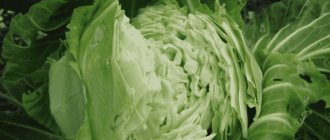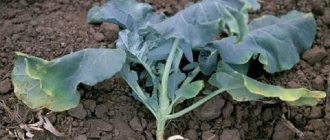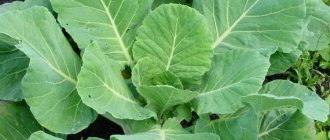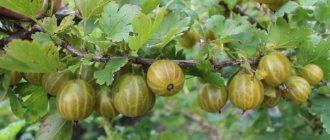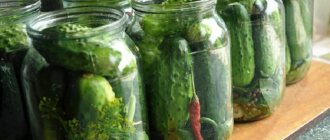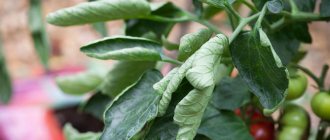» Vegetable growing » Cabbage » Why cabbage is bitter and what to do about it
0
1064
Article rating
Sometimes housewives, when preparing vegetable dishes, are faced with the fact that cabbage grows. An unpleasant taste may be the result of improper heat treatment or growing technology. Let's look at the main mistakes that lead to product damage.
- How to get rid of bitterness
Why is cabbage bitter and what to do about it?
Natural causes
Almost all cabbage stalks, as well as some of the leaves, have a slight bitterness - this is normal. The reason for the phenomenon is the content of glycosides in the vegetable, which are the plant’s natural defense against pathogens and pests.
Late and mid-late varieties are able to accumulate glycosides in greater quantities than varieties that ripen earlier. This also applies to hybrids of the Garden Lady variety.
These varieties are suitable for winter consumption after they have been left for some time. As a rule, they are used for food no earlier than February. They are distinguished by dense, bluish outer leaves that have a waxy coating and green leaves on the inside. The amount of glycosides decreases in proportion to storage time. The harvest of these varieties is stored in the cellar, until March the bitter taste disappears completely.
In summer and autumn, early and mid-season varieties are eaten, the leaves of which are light green or white. These same species are suitable for pickling for the winter.
Why is it bitter?
A healthy, vitamin-rich dish, prepared without heat treatment, will saturate the body with nutrients and microelements during the cold season.
Sauerkraut is an appetizing addition to a family dinner or holiday table, an alternative to fresh vegetables, which are expensive in winter and not always of acceptable quality. Let's talk about the causes of bitterness.
During the process of pickling cabbage, an acidic environment is formed inside the jar (barrel). This occurs as a result of the interaction of cabbage juice with salt, the fermentation process begins with the release of a large amount of gases.
If they do not come out, they accumulate in containers between the layers of cabbage, causing a bitter taste.
After placing it in the jar, the workpiece is pierced with a wooden stick to the very bottom. Repeat this procedure 1-2 times a day until the product is completely ready.
Too much or little salt
One of the common causes of a bitter taste is excess salt. Due to an excess of this ingredient, lactic acid bacteria die, as a result of which the fermentation process stops. The pickling technology is violated; foam does not appear in the jar, indicating proper fermentation. Cabbage loses its attractive light color and becomes grayish and bitter.
Lack of salt also negatively affects the taste of sauerkraut. Active fermentation occurs only through the interaction of salt and secreted juice. If there is a shortage of the first component, harmful bacteria are formed in the container instead of useful ones, and the process of rotting begins.
Wrong type of cabbage
All varieties are divided depending on the timing of their ripening. Experienced housewives know the rules for choosing white cabbage for fermentation:
- early varieties are not used, they do not produce a sufficient amount of sugars necessary for fermentation, and the tender leaves of the vegetable become soft and tasteless when pickled;
- mid-season varieties are fermented in northern, cold regions, since late cabbage does not have time to ripen during the short summer - the leaves are relatively hard and elastic, they contain enough sugar, but the taste of the finished product is not too pronounced;
- late varieties are an ideal choice for fermentation; by autumn, the heads of cabbage become crispy, juicy, and rich in vitamins and beneficial microelements.
The fork chosen for pickling is immediately tasted when slicing. There are specimens that have a bitter taste when fresh.
The following varieties and hybrids are considered the most suitable for pickling:
- Menza F1;
- Dobrovodskaya:
- Belarusian;
- Glory 1305;
- Snow White;
- Mara;
- Kharkov winter;
- Turkiz;
- Present.
When preparing heads of cabbage, the top green leaves are removed from them. The lightest and most elastic leaves are suitable for fermentation.
Nitrates
The unnatural bitterness of sauerkraut appears as a result of the accumulation of dangerous nitrates in vegetables, which are actively absorbed from the soil. A harvest saturated with harmful additives and chemicals is harmful to the body.
For pickling, only fully ripened varieties are used. Specimens untimely harvested from the garden are characterized by looseness and insufficient elasticity. Cabbage is cut no later than 1-2 days after the first frost. By this time, the vegetable is considered fully ripe.
When you lightly squeeze the head of cabbage, you hear a slight crackling sound, and it itself has a white tint - this means that the optimal amount of sugars has accumulated in the forks.
Before salting, the harvested crop is placed in a cellar or storage room for 12-14 days, during which time it will finally gain maturity.
The finished product with a slight bitterness is suitable for consumption, but this taste does not suit everyone.
This product does not pose a health hazard, but many housewives are trying to get rid of the bitter taste and save the vitamin preparation using affordable methods.
The presence of an unpleasant wormwood taste depends on several factors:
- unripe vegetables;
- violations of agricultural technology during cultivation;
- dry summer;
- a large number of chemical growth stimulants.
Let's look at each case separately and try to correct the situation.
Bitter sauerkraut can result from errors in choosing the main ingredient or from improper preparation of the dish. In this case, the fermentation process is not carried out actively enough and this leads to the proliferation of harmful microorganisms, which cause an unpleasant bitter taste in the finished product. Let's look at the main reasons for the bitter taste in finished snacks and figure out how to eliminate them.
An unpleasant bitter taste may appear in sauerkraut if it is not pierced before pickling. During the interaction of vegetable juice with salt, a special acidic environment is formed inside the container. As a result of the fermentation process, gases are formed that cannot leave the container on their own.
To prevent the occurrence of bitterness, it is recommended to take the following actions:
- Before cooking, pierce the head of cabbage in several places with a sharp wooden stick to release carbon dioxide.
- During the fermentation process, pierce the mixture in the jar with a wooden stick to the very bottom so that carbon dioxide does not accumulate and escapes. Repeat this procedure 2 times a day.
- After placing the shredded cabbage in the jars, you can immediately insert a wooden stick in the center of the container - it will absorb the unpleasant odor and prevent the occurrence of bitterness.
If these recommendations are followed, the resulting carbon dioxide will escape and will not affect the taste of the finished product.
The bitter taste of pickles can be caused by excess salt. At room temperature, the fermentation process begins in finely chopped and tightly packed cabbage mixed with salt. It is the result of the vital activity of lactic acid bacteria, which are formed as a result of contact of vegetable juice with salt.
Did you know? Just 100 g of fresh cabbage contains about 60% of the daily dose of vitamin C for an adult.
To fix the problem, you need to do the following:
- drain part of the brine from the jar and fill it to the top with clean cold water;
- if no more than 1–2 days have passed since pickling, you can add a small portion of fresh cabbage to the pickle, mix and put it back in a warm place to ferment;
- if oversalting was noticed a long time after putting the mass into jars, you can use the oversalted product to prepare cabbage soup, borscht or as a filling for pies.
The bitter taste of cabbage may be caused by a lack of salt used for cooking. An active fermentation process is possible only when the vegetable juice interacts with salt in a warm room. If there is a lack of salt, the necessary environment in which beneficial lactic acid bacteria multiply does not form inside the container. Instead, heat causes harmful bacteria to multiply in the cabbage, causing the product to rot.
Signs of a lack of salt in a jar of pickles are:
- gray color of vegetable pieces;
- cabbage becomes soft;
- the snack does not taste salty;
- the appearance of an unpleasant odor;
- the mass in the jar becomes covered with a slimy coating.
If the problem was noticed at an early stage of preparation, you can make up for the lack of salt in the jar. To do this, you need to drain part of the brine and add fresh salty solution to the container to stimulate the onset of fermentation. If a lack of salt was noticed a few days after preparing the snack and the vegetable had time to become soft and slimy, then it will no longer be possible to save the pickle. In addition to unpleasant bitterness, such a dish can cause poisoning in the human body.
Important! In a standard sauerkraut recipe, for every 10 kg of vegetable you need to use 200 g of salt.
For pickling, you can use cabbage of only medium and late ripening varieties. Early vegetables have heads that are too loose, and the leaves are thin and green. They are good for making fresh salads, but contain little sugar and become bitter during fermentation. Dense white heads of cabbage, which accumulate a lot of sugar during the ripening process, are more suitable for pickling.
Sometimes the bitter taste of sauerkraut appears as a result of the fact that it was cut from the garden at the wrong time. To prevent bitterness from appearing during pickling, the vegetable must be fully ripe.
Here are a few rules for choosing a suitable head of cabbage for pickling:
- It is recommended to cut the vegetable no earlier than 2 days after the first frost, since it is by this moment that it fully ripens;
- the cabbage should be firm and crack slightly when you press it with your hands;
- the head of cabbage should be white, this indicates that there is enough sugar in the leaves of the vegetable;
- the stalk should be juicy and dense;
- After cutting, the head of cabbage needs to lie down for another 1–2 weeks to finally gain maturity.
Growing errors
Excessive content of mineral fertilizers, nitrogenous compounds and nitrates, as well as a lack of potassium, phosphorus and microelements during fork formation give the crop a bitter taste. Cabbage becomes very bitter if a large amount of fertilizer is combined with poor watering.
Premature harvesting prevents the vegetable from ripening and acquiring its natural taste. Hot peppers grown nearby transmit their taste qualities to the neighborhood, so they cannot be planted in close proximity.
Cabbage is bitter if the bitter substances have increased due to unfavorable factors, such as extreme heat or drought. During watering, it is important not to forget to treat with potassium humate. Cabbage beds are watered in accordance with the variety and weather conditions. Cabbage loves water - be sure to take this fact into account when growing.
Harvesting must be carried out no later and no earlier than the established deadlines. Proper crop rotation in the garden helps produce great-tasting forks.
How to get rid of bitterness
Soaking in water will remove the bitterness of fresh cabbage.
The bitterness from the heads of early varieties goes away if you put their leaves in boiling water for a minute. You can also remove the bitterness from cabbage by finely chopping it and then keeping it in water for half an hour.
Sauerkraut will not taste bitter if you pierce it in 5-10 places with a thin wooden stick 2-3 days after pickling, and then place it in a cold place. Sauerkraut is washed only with cool boiled water, but not hot or warm: this will deprive it of its taste and all its beneficial substances.
If late cabbage is noticeably bitter, due to the fact that it was picked before the first frost, its bitterness cannot be removed: it will not disappear even after storage.
Sauerkraut or fresh cabbage, which due to long storage has lost its positive qualities and is bitter, must be thrown away without regret.
Reviews
Katerina, 39 years old. If you grind the cabbage, the bitterness will disappear. Or you can scald the leaves with hot water. If the head of cabbage itself is not wet, then there is no need to drain the water after grinding, but after scalding it is necessary. I always crumple. It tastes better and is easier to digest.
Olga, 42 years old. I use plain apple cider vinegar. When I cut the bitter cabbage, I simply add a small portion of apple cider vinegar. Mix thoroughly. After an hour, I drain the resulting liquid. I use ready-made cabbage for cooking.
Any variety of this vegetable contains vitamins and is good for health. It is used in the treatment of diseases, as well as their prevention. To make it pleasant to eat, you need to eliminate the bitterness using known methods.
After harvesting or purchasing white cabbage, the housewife may discover bitterness in it. Cabbage is bitter for several reasons.
Causes of bitterness in fresh cabbage
Bitterness in Cauliflower and Brussels Sprouts
Fresh cauliflower sometimes tastes bitter. To deal with this, it is scalded with boiling water or boiled. Salted and acidified water, if you soak cabbage in it, will also relieve it of bitterness. A good solution to the problem is to spray the disassembled inflorescences with lemon juice.
Bitter Brussels sprouts are deprived of this quality using proven means. There are 2 main methods used in cooking:
- When cooking, add a few drops of lemon juice to the water. When cooking using a double boiler, add a little more lemon juice to the water.
- Place the cabbage in boiling water for a few seconds. After this, drain the liquid, pour in fresh liquid, bring to a boil and cook for 10 minutes.
Two popular recipes for salad with white cabbage
In conclusion, simple, but no less worthy recipes for vitamin salads.
See also: How and how long to cook pork liver until done
Cole Slow Salad
✍ Ingredients:
- 1/2 head of white cabbage
- 1 sweet pepper
- 1 carrot
- 1 small onion (red onion)
- 1 sweet and sour apple
- salt and sugar to taste 1/2 tbsp. mayonnaise
- 1 tsp mustard
- 1 tbsp. apple cider vinegar
Preparation:
- Finely chop the cabbage, place in a bowl, add salt and sugar. Mash with your hands until the juice appears.
- Cut the onion into thin half rings. Grate the carrots on a coarse grater. Cut the pepper and peeled apple into strips. Mix all.
- For dressing, mix mayonnaise with mustard and vinegar. If desired, replace mayonnaise with sour cream or neutral yogurt.
- Mix the ingredients thoroughly with the resulting sauce.
- Place in the refrigerator for 30 minutes before serving.
The salad turns out most delicious if young cabbage is used. In this case, it should not be crushed; it is already quite juicy.
Green salad
✍ Ingredients:
- 1/4 head of white cabbage
- 1 cucumber
- 1 can of canned peas
- dill and parsley - to taste
- mayonnaise - to taste (see what you can replace it with here)
Preparation:
- Finely chop the cabbage, add salt and mash with your hands in a deep bowl.
- Cut the cucumber into quarters.
- Drain the liquid from the peas and add to the mixture along with the cucumber.
- Finely chop the greens and add to the total mass.
- Add mayonnaise, mix everything well.
This salad is best served immediately after preparation - this way the cucumber will not have time to release a lot of liquid due to the addition of salt.
For 7 more recipes for vitamin salads, see this collection.
